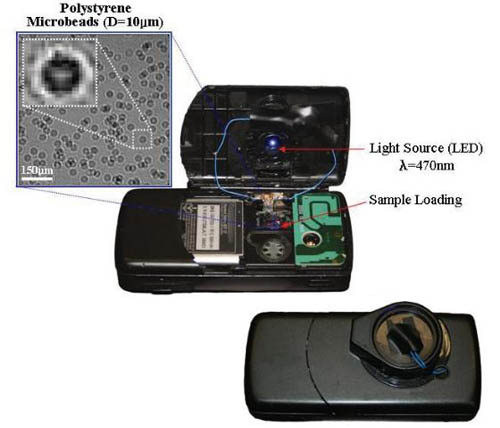Cell Phones Would Help In Monitoring Health
 According to a UCLA electrical engineering professor, he has developed a cell phone that can monitor the conditions of HIV/AIDS and malaria patients as well as test water quality in undeveloped areas or disaster sites. A new imaging platform called 'LUCAS'(Lenseless Ultra-wide-field Cell minitoring Array platform based on Shadow imaging), has been developed by Aydogan Ozcan and successfully installed in a cell phone and webcam. An image is acquired for both of the devices, using a short wavelength blue light to illuminate a sample- blood, saliva or any other fluid. LUCAS captures an image of the micro particles in the solution using a sensor array. All these particles have a distinct shadow image that can be identified and counted by a custom-built "decision algorithm" that compares the captured shadow images to a library of training images. Then the collected data can be sent to a hospital for analysis, using the cell phone, or transferred through a computer (using USB).
According to a UCLA electrical engineering professor, he has developed a cell phone that can monitor the conditions of HIV/AIDS and malaria patients as well as test water quality in undeveloped areas or disaster sites. A new imaging platform called 'LUCAS'(Lenseless Ultra-wide-field Cell minitoring Array platform based on Shadow imaging), has been developed by Aydogan Ozcan and successfully installed in a cell phone and webcam. An image is acquired for both of the devices, using a short wavelength blue light to illuminate a sample- blood, saliva or any other fluid. LUCAS captures an image of the micro particles in the solution using a sensor array. All these particles have a distinct shadow image that can be identified and counted by a custom-built "decision algorithm" that compares the captured shadow images to a library of training images. Then the collected data can be sent to a hospital for analysis, using the cell phone, or transferred through a computer (using USB).
In the journal Lab on a Chip, Ozcan described an improvement in the LUCAS system that allows for identification of smaller particles such as E. coli that were not possible earlier and he calls it holographic LUCAS. Japanese researchers have approached Ozcan to use it for earthquake preparedness. Ozcan said: "This technology will not only have great impact in health care applications, it also has the potential to replace cytometers in research labs at a fraction of the cost." He added, "A conventional flow-cytometer identifies cells serially, one at a time, whereas tabletop versions of LUCAS can identify thousands of cells in a second, all in parallel, with the same accuracy."
For undeveloped areas, LUCAS would be useful for water testing in the event of a disaster which compromises water quality.